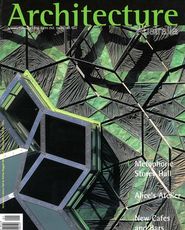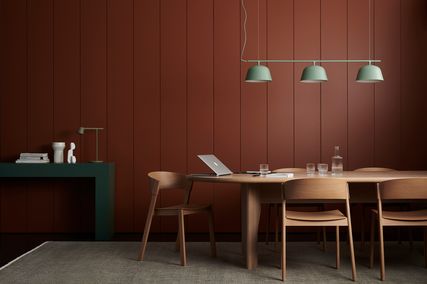|
Convict prison, reform school dockyards—is this rich heritage of Sydney’s Cockatoo Island sanitised by housing? Hoping not, UNSW landscape students arrranged the Biloela to expose more sensitive ideas. In Sydney, there are over 40 significant sites between the bridge and Parramatta for which the logic of a harbour address has evaporated. To sell one, Cockatoo Island, to create a “whole new suburb” (as proposed by Leo Schofield, chairman of the federal government’s Heritage Property Review Committee) seems plausibly inevitable because it is so consistent with current urban consolidation policies for redundant industrial sites and with the chaotic but pragmatic shifts in use that have been Cockatoo’s history to date. Why then does the prospect raise so much ire that a competition is held to articulate alternative directions?
The emotion and polemic is stirred as much by the impending loss of `what might have been’ as by any intrinsic worth the island has or by the worth of any proposal for it. It is easier to feel solidarity with this sense of impending loss than universal support for a particular proposal. Biloela , the recent urban design competition for Cockatoo, was organised by landscape architecture students at the University of NSW as a strategy to collect ammunition for a public debate about the island’s future. Jurors were Richard Francis-Jones (chair), Cristina Felsenhardt, Richard Goodwin, Cath Rush and Vladimir Sitta. Three winners were announced at The Big Sky conference in October: Ross Ramus and 14 RMIT students (Melbourne), first; James McGrath (Sydney), second, and Mathis and Michael Güller and Markus Schäfer (Switzerland), third. Commendations went to Jason McNamee (Melbourne) and Richard Weller (Perth). As with all competitions, it is the elegance of an idea and its resolution that wins the day. Rarely are complex or ambivalent statements chosen. Instead the many directions available are represented through the curatorial selection of the jury. The five premiated schemes, which the jury considered “a set”, literally though unintentionally scoped Cockatoo’s history—with different phases providing the starting points for the various schemes’ trajectories: Weller, nature; McNamee, prison; McGrath, institution; Ramus, work place and Güller Güller Schäfer, the emerald city on the Hollywood axis.
The jury was keenly aware of the effect of ranking—with the most pragmatic scheme placed first and the most confronting receiving commendations. Astutely, the pragmatic is the Trojan horse for the other schemes’ theoretically challenging ideas. Weller’s proposal is the most shocking: that the island be planted with a grid of figs—to remain untouched for 100 years to provide a habitat for displaced bats and the slow spectacle of heritage items being consumed by the figs’ voracious roots. It upsets the economic and heritage framework and forces a confrontation with the deep suspicion and apprehension that is felt towards the rationale of `deep ecology’. It disrupts the basis of planning legislation by creating, rather than just protecting, a habitat. Clearly this is a proposal to send economic rationalists into a tailspin, so best kept in reserve. Paradoxically though, the proposal could receive the support of adjacent waterfront property owners who would be better served by a forested outlook than vacant industrial land—a happy marriage of speculative deep ecology and property speculation.
There is no evidence of occupation of Cockatoo until 1839. In that year, the awful logics of the penal colony coalesced in the need to relocate prisoners from Norfolk and Goat Islands, and the eternal problem of the forced labour camp—how to exploit the labour—seemed soluble through imperatives for secure storage of a bumper wheat crop and (later) a dry dock. The convicts were set to quarrying for quick cash to offset the cost of their segregation; the excavation of 20 bottle-shaped granaries in the rock. McNamee’s scheme for public cultural facilities and incarceration collapses notions of segregating prisoners—but still within the controllable confines of the island. The logic of the body isolated by water remains.
The jury considered McNamee’s vision “frightening”—but is it really so different from the confrontation of a businessman and a derelict sheltering in a city doorway, made acceptable by the eye of the surveillance camera? Doesn’t this express the very essence of public space— that private “gated communities” and private “public” spaces (theme parks, malls) would deny? After the granaries, the next convict project on Cockatoo was the excavation and lining of the Fitzroy Dock between 1847 and 1854. Maritime industrial uses continued on the island, with wild fluctuations in employment, until 1989. The collaborative scheme of Ramus and students suggests a return to maritime industry and commerce of every conceivable nature. The briny logic of the entry “to avoid the arbitrary transfer of functions and uses better located on land” is hard to argue with but the unrelieved nautical nature of every element, and the piscean aroma that would envelope the island, suggest a theme park—despite the jury’s comment that “it is the antithesis of theme parks of all kinds suggested in a number of other entries”. Again the exigencies of competition entries to tie (sorry, belay) all those loose ends has reduced credibility of an entry that above all is trying to be “authentic”. I can’t help but say: loosen up, relax, allow it to happen over time. However, as a rostrum for public debate about the island, it is a wise strategic choice. Despite the uncanny and detailed sensitivity for the topography of the site shown in the scheme by the Güllers and Schäfer, their proposal for “another big stage for happenings, a factory for art … the island is to be publicly rejuvenated through a popular dreaming as a new site of cultural production—a film and television school” in the words of the jury, it is difficult not to see this optimistic program being subverted by a Kevin Costner Waterworld Ride. Otherwise why not leave it on the land? Convicts inhabited the island for 70 years until the opening of Long Bay Gaol in 1909. The island also accommodated over the years an industrial school for orphans and neglected girls, a reformatory for convicted women, and a number of “nautical training ships” for naughty and orphaned boys. McGrath’s scheme proposes a new institution: a cultural and artists’ colony. Inhabiting the modified granaries, with new galleries and chambers cut in the rock and a complex fractured exoskeleton inhabiting the wharfage skirts of the island, this proposal visualises “a permanent community of artists on scholarship or such, working on the island with their own apartments and studio/workshops. A temporary community would be made up of people who come for a day to be saturated in a bombardment of cultural spectacle—from concerts and computer centres to cinema complexes and libraries”. The need to define activities is probably the weakest part of the competition. As designers we are bound to designate the activities that will inhabit our works of beauty. A sort of `wouldn’t it be lovely’ design rationale—but whether an activity will or won’t occur has little to with the beauty of the architecture—or does it? McGrath sees the island as a “supercharger” of activities but it could also be thought of as a social capacitor. If touched too heavily then its latency is lost—and privatisation is the heaviest touch of all. This latency is a fundamental characteristic of public space—where else are the rituals, festivals and self-consciousness of an ideal society to be located? The potency of public space is precisely in its unexpended potential. Perhaps just incrementally, ephemerally, allow them to be used … discover what works. Rod Simpson is a Sydney architect concerned with environmentally sustainable urban design. A provincial city’s quest for a progressive symbol galvanised architects around the world—and Melbourne’s Garner Davis win the commission.Architectural competitions have always been contentious events. From the British Houses of Parliament to the Museum of Victoria, architects and their reputations have been rarely so publicly displayed as in a competition. Even before the winner of the Wagga Wagga Civic Centre commission had been announced, letters denouncing the judging had already appeared in the press. Yet the competition as a whole seemed to have been well run [convenor Stephen Varady and a supportive city council], with an excellent brief and a high quality jury [Bob Nation (chair), Peter Wilson, Leon van Schaik, Sand Helsel and the council’s general manager, Brian Andrews]. That after the event it might be easy to disagree with some of the finalists or complain that a few excellent schemes did not make the shortlist is merely a sign of a very competitive field and the general high quality of the ideas proposed. For their five finalists, they chose three designs which were eminently buildable and two visionary, seductive, works. In this visionary category were the works by LAB (London: Peter Davidson, Donald Bates and others) and Four Over One (Perth: architect Gregory Cowan with Rebecca Angus, Glen Chamberlain, Chrisopher Johnson and Andrea Veccia-Scavalli). In the former category were the entries from Godfrey Spowers (Melbourne), Durbach Block and Collier (Sydney) and the eventual winner of the entire competition, Garner Davis (Melbourne). Other than the five finalists, the jury also awarded honourable mentions to three first stage entries - Field Consultants (Michael Markman and Peter Brew) and Edmond and Corrigan, both of Melbourne, and Michael Sorkin of New York. Proposals by five finalists can be analysed as follows: LAB
Four Over One
Godfrey Spowers
Durbach Block and Collier
Garner Davis
Michael Ostwald is a lecturer in architecture at the University of Newcastle. |
Source

Archive
Published online: 1 Jan 1996
Words:
Roderick Simpson,
Professor Michael J. Ostwald
Issue
Architecture Australia, January 1996

 Winning Cockatoo scheme by RMIT students of Ross Ramus
Winning Cockatoo scheme by RMIT students of Ross Ramus  Plan
Plan  Jason McNamee’s “frightening” vision.
Jason McNamee’s “frightening” vision. 
 James McGrath addresses the tunnels
James McGrath addresses the tunnels  Model by LAB
Model by LAB Model by LAB
Model by LAB Sketch by Four Over One
Sketch by Four Over One Plan by Four Over One
Plan by Four Over One Model by Four Over One
Model by Four Over One Model by Four Over One
Model by Four Over One Godfrey Spowers’ model
Godfrey Spowers’ model Godfrey Spowers’ elevation drawing
Godfrey Spowers’ elevation drawing Durbach Block and Collier model
Durbach Block and Collier model Durbach Block and Collier model
Durbach Block and Collier model The winning scheme by Garner Davis of Melbourne
The winning scheme by Garner Davis of Melbourne The winning scheme by Garner Davis of Melbourne
The winning scheme by Garner Davis of Melbourne












